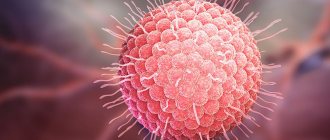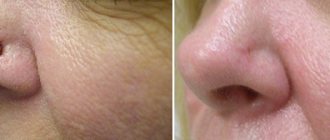A food allergy is an adverse reaction of the immune system to proteins in food.
In general, around the world, about 2.5% of the world's population suffers from food allergies; this figure varies in different countries, ranging from 1 to 10%. According to the World Allergy Organization (WAO), as well as the European Academy of Allergy and Clinical Immunology (EAACI), there is a current increase in the incidence of food allergies and a steady increase in this disease is predicted in the coming years.
The EAACI white paper (2018) states that by 2050, more than 4 billion people will suffer from allergic diseases worldwide.
Price
Allergology-immunology
| Name of service | Price |
| Consultation with an allergist-immunologist | 5 000 ₽ |
Advantages
- The latest, constantly updated equipment
- Interest-free installments for all services
- Online consultations with an ENT doctor
- Visit of an ENT doctor to your home
- Friendly and qualified staff
- 24/7 ENT assistance
A food allergy is an abnormal reaction of the immune system that occurs shortly after eating a certain food. Even small amounts of an allergic food can cause signs of a food allergy, such as digestive problems, swelling and skin marks. In some people, food allergies can cause serious symptoms or even a life-threatening reaction called angioedema (swelling of the airways) - also known as Quincke's edema.
You should not tolerate a condition that can significantly reduce your quality of life. Contact a professional allergist who will determine the source of your food allergy and give competent clinical recommendations.
Symptoms of food allergies
Manifestations of food allergies usually develop within a few minutes to two hours after consuming the trigger food. In more rare cases – up to several days.
The most common symptoms of food allergies include:
- discomfort in the oral cavity;
- skin form of food allergy: redness, rashes in the form of small blisters, itching;
- swelling of the lips, face, tongue and throat (mostly) or other parts of the body (less often);
- difficulty swallowing;
- wheezing or shortness of breath;
- nasal congestion or difficulty breathing;
- abdominal pain, diarrhea, nausea or vomiting;
- dizziness, feeling unwell;
- sneezing or itchy eyes (allergic conjunctivitis).
Possible complications
The danger is that this condition gradually worsens if no measures are taken over time:
1. First, against the background of sensitization, the body develops dermatitis.
2. Then the respiratory system is damaged in the form of atopic rhinitis.
3. If the antigen is not excluded, then bronchial asthma manifests itself.
The most dangerous complication is anaphylactic shock. It develops rapidly – 1-3 minutes after contact with the antigen. It is characterized by bronchospasm, laryngeal edema and collapse, which can be fatal if not treated promptly.
Angioedema - or how food allergies manifest themselves in the worst way?
Acute food allergies can cause a serious allergic reaction called angioedema. Prompt treatment is critical for this condition. Without treatment, angioedema can cause asphyxia, coma, or even death.
Life-threatening signs of a food allergy:
- tongue swelling;
- a feeling of a lump in the throat that makes it difficult to breathe;
- problems swallowing or speaking;
- a sharp drop in blood pressure;
- rapid pulse;
- dizziness, lightheadedness, or loss of consciousness
With such symptoms, you should urgently call an ambulance.
Food allergies in children
Childhood food allergies affect 6 to 8% of children under 3 years of age. Often, food allergies in children go away without treatment as they grow older, but you should not wait for this to happen and neglect medical help. Food allergies in a child can affect his growth and development, so in any case you should consult a doctor.
A food allergy in a newborn may manifest itself not as rashes on the body, but as excessive and inconsolable crying, even if the child is fed and does not need to change diapers. This occurs due to colic in the abdomen.
The following foods most often cause an allergic reaction in children:
- eggs;
- milk (if a baby has a food allergy to any type of milk, as well as to baby food and formulas that include milk, it is imperative to include other foods containing calcium in his diet);
- soy;
- wheat;
- peanut.
What is the danger of developing food allergies?
Data from numerous scientific studies show that increased sensitivity to a certain food substance is accompanied by the development of immune reactions, which are called sensitization to this product. The appearance of food allergies in the first two years of a child’s life increases the risk of developing asthma and allergic rhinitis in later life. Therefore, parents’ alertness and correct diagnosis of food allergies by a doctor make it possible to identify children at high risk of subsequent development of atopic dermatitis and respiratory allergies and develop the necessary recommendations and preventive measures.
It is important for every family to understand the role of family allergy history. It should be taken into account that the way the functions of the child’s immune system are implemented is influenced by many factors and, above all, genetic predisposition to the development of allergies. So, if one parent in the family has an allergic disease, the risk of developing an allergy in the child reaches 60%; if both parents have an allergic disease, then the risk increases to 80%. In one foreign study, a high level of family history of allergies was documented and confirmed in children with a food allergy to cow's milk protein. The prevalence of allergic diseases among first-degree relatives (mother, father, brothers, sisters) of children with an allergy to CMP reached 88%. In addition, important factors for the development of primary allergic reactions are: excessive intake of food antigens into the child’s body in the prenatal period and through breast milk, delayed time of breastfeeding after birth, shortened duration of natural feeding, the nature of the food antigen, its dose (quantity), frequency of administration, chemical structure, age of the child at first contact with food antigens.
According to scientific research, the most common allergens in infants with food allergies are: animal milk proteins (cow's milk proteins, goat's milk proteins) - up to 85%; soy proteins – up to 28%; chicken egg whites - at 5 months it is registered in 15%, by 1-1.5 years - in 90%; wheat proteins by 1 year of life – in 5–15% of patients.
Types and causes of food allergies
Food allergies occur because the immune system perceives harmless substances in certain foods as harmful.
In the most common type of food allergy, an antibody known as immunoglobulin E (IgE) mistakenly targets a specific protein found in food as a threat. Immunoglobulin is involved in the release of a number of chemicals that form an allergic reaction, the most serious of which is histamine. It causes most of the typical symptoms of an allergic reaction. For example, histamine:
- causes small blood vessels to dilate, causing food allergies in the skin (the skin becomes red and swollen);
- increases the amount of mucus produced by the nasal mucosa, which causes sneezing, itching and burning.
There is another type of food allergy known as non-IgE-mediated food allergy. It is more difficult to diagnose because there is no test that can accurately confirm it. This type of food allergy also manifests itself on the body and causes problems with the digestive system (heartburn, diarrhea, nausea). In infants, non-IgE-mediated food allergies can also cause diarrhea and reflux, when stomach acid leaks into the throat.
Food allergies in adults are most often caused by the following foods:
- nuts – walnuts, almonds, peanuts, pistachios;
- fish;
- seafood - shellfish, crabs, lobsters and shrimp;
- celery;
- Gluten is an allergy to food protein found in grains;
- mustard;
- fruits and vegetables - usually food allergies in adults to them occur only on the skin around the mouth;
- meat – some people are allergic to only one type of meat, others are allergic to different types; the main manifestation is food allergy on the face;
- alcohol;
- non-steroidal anti-inflammatory drugs - aspirin or ibuprofen.
Immune system reactions
Allergies to food proteins can be mediated by IgE (immunoglobulins) and/or T-lymphocytes.
Its course and manifestation depend on this: • In the first case, the reaction develops instantly, which is typical for asthma, urticaria and anaphylactic shock. • In the second case, delayed-type hypersensitivity occurs. The most typical manifestation is protein gastroenteropathy. • In the third case, there is a delayed onset response due to a chronic course (for example, atopic dermatitis).
If the reaction manifests itself as gastroenteropathy, it is advisable to take enterosorbents (Polysorb, activated carbon, Laktofiltrum) along with antihistamines. Cytotoxic and immunocomplex reactions to food allergens are not detected. But there is a high risk of cross-sensitization, when sensitivity is increased by other irritants (pollen or latex).
Diagnosis of food allergies
The main method of identifying the cause of food allergies is keeping a food diary for several weeks, which allows you to identify the causative factor and significantly narrow the range of suspicious foods. Food allergy tests are always just an additional tool and are not a basis for excluding a product from the diet.
Testing for food allergies can vary depending on the type:
- if symptoms develop quickly (IgE-mediated food allergy), a skin test and blood test will be performed;
- if symptoms develop more slowly (non-IgE-mediated food allergy), a diet that excludes certain foods will be prescribed to identify the allergen.
During a food allergy skin test, drops of standardized food extracts are applied to the skin. The skin is then pierced with a small lancet, which allows the allergen to come into contact with immune system cells. Itching, redness and swelling indicate a positive reaction.
A food allergy blood test measures the amount of allergic antibodies in the blood.
The food allergy diet eliminates foods that are believed to cause the allergic reaction. Typically restrictions are imposed for 2-6 weeks. These products are then reintroduced. If symptoms disappear without trigger foods but return when they are reintroduced, this indicates a food allergy or intolerance to those foods.
Do not attempt a food elimination diet on your own without discussing it with a qualified allergist.
Prevention measures
Complete recovery is possible only with early identification of factors and their exclusion from the diet. By following nutritional recommendations, relapses of the disease can be prevented. Some children experience spontaneous recovery as oral tolerance increases. Many people “outgrow” the disease, but you shouldn’t count on it.
Treatment of food allergies
Therapy for food allergies consists of two components: elimination therapy (excluding causative foods from the diet) and drug therapy for manifestations of the disease.
There are 2 main types of medications that are prescribed to relieve the symptoms of an allergic reaction:
- Antihistamines – used to treat mild to moderate allergies. They work by blocking the production of histamine, which is responsible for initiating an allergic reaction. Avoid drinking alcohol after taking antihistamines as it may cause drowsiness.
- Corticosteroids are stronger drugs. They inhibit the production of substances that promote inflammation, reduce capillary permeability, which eliminates swelling.
When asked how to treat severe food allergies (anaphylaxis), the answer is adrenaline. Adrenaline constricts blood vessels and opens the airways to ease breathing difficulties. This procedure should only be performed by qualified healthcare professionals.
A food allergy is an excessive reaction of the body to substances contained in certain types of food. As a result, consuming even small amounts of such products causes unpleasant symptoms. Food allergies are often confused with intolerance to certain types of food, since their symptoms are similar, but with intolerance the immune system is not involved in the pathological reaction.
In most people, the manifestations of food allergies are moderate, although anaphylactic shock, a serious life-threatening condition, rarely occurs.
Food allergies affect 2-3% of adults and 6-8% of children under 6 years of age. 5% of them develop bronchial asthma. There is no cure for food allergies, but more than half of children outgrow it. The main importance is the complete exclusion from the diet of foods that cause an allergic reaction.
Synonyms Russian
Nutritional allergy.
English synonyms
Allergy to food, food allergies, alimentary allergy.
Symptoms
Typically, symptoms of food allergy develop immediately, within the first minutes and no later than two hours after the allergen enters the body. Less common is the so-called delayed version of an allergic reaction, when symptoms develop over a period of several hours to several days and are less pronounced. The combination of immediate and delayed food allergies is especially common in children.
The main symptoms of food allergies are:
- rash,
- itching,
- swelling of the face, neck, lips, tongue,
- difficulty breathing,
- cough,
- runny nose, lacrimation,
- abdominal pain,
- diarrhea,
- nausea, vomiting,
- malaise, weakness.
general information
Food allergies are based on an excessive reaction of the body's immune system to components of certain foods - allergens. With food allergies, blood cells (lymphocytes) produce specific proteins - immunoglobulins E, which interact with food proteins. That is, a reaction occurs similar to the body’s response to pathogenic microorganisms entering it, but mistakenly directed at the proteins of certain products.
When immunoglobulins E interact with an allergen, biologically active substances are released that affect various organs - skin, respiratory tract, gastrointestinal tract. As a result, characteristic allergy symptoms arise: rash, itching, swelling, breathing problems, and disruption of the digestive system. With the participation of immunoglobulins E, an immediate reaction to the allergen occurs.
When an allergen enters the body for a long time, immunoglobulins G react. A delayed, delayed allergic reaction is formed. Most often, it manifests itself as a rash and itchy skin that develops over several hours or days, which makes diagnosing this type of food allergy much more difficult. Children may experience colic, constipation, and flatulence, often in combination with symptoms of an immediate reaction to the allergen.
A very severe reaction to an allergen can cause anaphylaxis (anaphylactic shock). Anaphylaxis develops within a few minutes after a food allergen enters the body and is accompanied by severe difficulty breathing, swelling of the face and lips, pallor, a drop in blood pressure, rapid spread of a rash, and itchy skin. If you suspect anaphylactic shock, you should seek immediate medical attention as it can be fatal.
Most often, allergies are caused by chicken eggs, milk, soy, wheat, peanuts, tree nuts, fish, and shellfish. In some cases, cross-reactions occur, meaning that a person with a peanut allergy may have a reaction to beans, or a person with a wheat allergy may have a reaction to rye.
The prevalence of allergies to a certain type of food also depends on the region of residence. For example, in Norway the most common food allergy is fish, in Japan - rice.
Over the past decades, food allergies have become much more common, especially among children. This is associated, on the one hand, with changes in the principles of nutrition of children in the first years of life, and on the other hand, with the fact that children grow up in a “sterile” environment, which complicates the full development of the immune system.
However, most children outgrow food allergies. This means that a child who suffered from an allergy to any product during the first years of life can get rid of it by adolescence. This apparently occurs due to the cessation of the production of specific immunoglobulins with prolonged exclusion of the allergen from the diet. Adults with an allergy to any food component are usually forced to permanently eliminate it from the diet.
Who is at risk?
- People whose relatives suffer from food allergies
- Patients with other types of allergies - bronchial asthma, atopic dermatitis.
Diagnostics
In diagnosing food allergies, it is important to examine the patient and carefully question him to identify the connection between the intake of certain foods and the symptoms of an allergic reaction. If identifying the allergen is difficult, the doctor may prescribe a number of additional tests.
Laboratory diagnostics
- Complete blood count (without leukocyte formula and ESR). With food allergies, the level of eosinophils - leukocytes (white blood cells), which are involved in allergic reactions due to the release of biologically active substances, such as histamine, may increase.
- Determination of the amount of immunoglobulin E in the blood. Immunoglobulins E are proteins that come into contact with the allergen, which leads to the release of active substances and the appearance of symptoms. Their level may be increased in food allergies.
- Determination of specific immunoglobulins E and G - to identify a specific food component that causes an allergic reaction.
Other research methods
- Food diary analysis. It consists of carefully recording the time of food intake, its composition and the time of onset of allergy symptoms. Helps the doctor establish the relationship between taking certain foods and the occurrence of allergic reactions.
- Elimination tests. The component that may cause the allergy is removed from the diet, and the patient’s condition is monitored.
- Provocative tests. After eliminating the probable allergen from the diet and the symptoms disappearing, the patient is given this allergen and the body’s reaction is monitored.
- Skin allergy tests. A small amount of allergen solution is applied to the skin of the inner side of the forearm, and then a small injection is made to a depth of 1 mm (prick test) or a scratch (scarification test). Redness of the skin and swelling in this area confirms the likelihood of an allergy to this substance.
Treatment
Food allergies cannot be cured, and their manifestations can only be prevented by completely eliminating contact with the allergen. In addition, there are antiallergic drugs that can reduce the symptoms of allergies. The effect of such drugs is based on suppressing the release of substances involved in the formation of the main symptoms.
Prevention
- Exclusion from the diet of foods that cause allergies.
- Breastfeeding or use, if necessary, hypoallergenic formulas during the first 6 months of the child’s life.
- Eliminating major food allergens from a child’s diet until the age of three.
Recommended tests
- General blood analysis
- Determination of specific IgG to the 90 most common food allergens
- Total immunoglobulin E (IgE) in serum
Food allergies: recommendations to avoid
The most effective prevention of food allergies is to eliminate foods that act as allergens from the diet.
It is important to always check the ingredient list on all pre-packaged foods and drinks. Pay attention to “may contain” labels, such as “may contain traces of peanuts.”
Be careful with products labeled as vegan. There is no official definition of veganism, which means that products under such brands are not always completely free of animal substances. If you have food allergies to milk, eggs, fish, crustaceans or shellfish, carefully read the ingredient lists of vegan products. Pay attention to "may contain" warning labels.
The Ear, Nose and Throat Clinic in Moscow treats food allergies in adults and children. You can also get tested for food allergies with us.
Seeing a doctor in a timely manner will help maintain your health.
Don't delay treatment, call right now. We work around the clock. tel. (24 hours a day)
What about the children?
Food allergies in a child are a serious problem. Therefore, the main task of parents is to quickly identify the product that causes the allergy and exclude it from the baby’s diet. Food allergies in infants, like food allergies in children 2 years of age and older, are manifested by various rashes: nodules, blisters, pink or red spots. The allergy is located on the face, neck, skin of the extensor surfaces of the joints, torso, buttocks, and itchy skin. The baby eats poorly, sleeps poorly, becomes capricious and restless.
By the way, the statement that a child may be allergic to mother’s milk is nothing more than a myth! Most likely, the baby’s body reacts to allergens that enter the mother’s milk along with food: perhaps the mother ate an egg, fish, chocolate or peanuts the day before...
Various congenital diseases associated with metabolic disorders, for example, phenylketonuria, can also disguise themselves as symptoms of food allergies in children. With such diseases, the body is not able to absorb certain substances - proteins, carbohydrates, etc. The diagnosis can be made through a series of biochemical and genetic studies.









